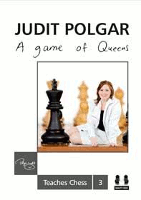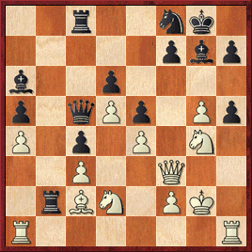The Recipe for Chess Success
Review by Brian Almeida
A Game of Queens, Judit Polgar, Quality Chess 2014, Hardback, Figurine Algebraic Notation, 390pp. $34.95 (ChessCafe Price $29.84)
A Game of Queens completes Judit Polgar’s trilogy about her thirty-year chess career. The first volume, How I Beat Fischer’s Record, covers the period from her early years until 1991, when she became the youngest ever grandmaster (at the time) at the age of 15 years, 4 months, and 28 days. The second volume, From GM to Top Ten, covers the period from her first tournament as a grandmaster in 1992 until 2000. This third volume covers the period from 2001 until the present day. It was during this time period that she joined the ranks of the top ten players in the world. Polgar has been ranked first on the Women’s rating list since 1989 and in 2005 she became the only woman in chess history to participate in the world championship final.

How I Beat Fischer’s Record won the 2013 ECF Book of the Year prize, and From GM to Top Ten was the ACP Book of the Year for 2014. A Game of Queens is sure to join these as an award winner as well.
The main content is as follows:
- Kasparov
- Karpov
- Korchnoi
- The Rapid Match with Anand
- Oliver
- Hanna
- The Opening
- The Middlegame
- The Endgame
- Unexpected Moves
- Official Competitions
- Where It All Started
- Records and Results
The material is structured as a manual, rather than an autobiography, in order to be more instructive for young players and amateurs and to serve as a guidebook to parents or trainers. Of course, there are plenty of autobiographical anecdotes interspersed throughout, but not necessarily in chronological order.
The first four chapters of this volume detail her games against four of the greatest players in chess history. Polgar describes Kasparov as a “killer”: “you could not help the feeling that he would eat you alive”; Karpov as a “positional magician”: “the greatest player [she] ever met”; and Korchnoi as an “uncompromising fighter.” She describes the formula for their outstanding results as follows:
“Talent, training, love for the game or even fanaticism, support, fighting spirit, perseverance, knowledge, timing, critical thinking, motivation, ambition, presence, individual character, discipline, preparation, ability to deal with pressure, ability to make decisions, spotting mistakes and correcting them, a certain degree of selfishness, reacting properly to the unexpected, spontaneity, good memory, concentration, focus, diligence, ability to handle time trouble, using the thinking time rationally, recovering in time after losses and victories…”
So there you have it. The complete recipe for chess success. Good luck!
The next to chapters cover the challenges of combining motherhood and a chess career; the next three chapters find Polgar sharing her views on the interconnection of the various phases of the game via accompanying illustrative examples. The chapter, “Unexpected Moves,” is self-descriptive. Polgar notes “the strong contrast between the logical fluency of the former three chapters and the abrupt changes of situation in the latter offers a compete overview of the game of chess in general.” The most memorable moments of her career are detailed in “Official Competitions,” and the final chapter is devoted to her win over Gelfand at the 2009 Khanty-Mansiysk World Cup, which she credits as the impetus to write this series of books.
Let’s look at an example from the game Judit Polgar – Ivan Sokolov, Wijk aan Zee 2005. We join the position after 31…gxf5 and provide select notes and diagrams from the book:

[FEN “2r2nk1/5pbp/b2p4/p1qPp1Pp/P1p1P1N1/2P2Q2/1rBN1PK1/R6R w – – 0 32”]
32.Nf6+!
If 32.Nh6+? Bxh6 33.gxh6 Ng6 34.Qf6 Kf8 and the king escapes.
32…Bxf6
Practically forced.
33.gxf6

[FEN “2r2nk1/5p1p/b2p1P2/p1qPp2p/P1p1P3/2P2Q2/1rBN1PK1/R6R b – – 0 33”]
33…Ng6
After Ivan’s last move, many people (including my second!) thought my attack was about to run out of steam. I had my own secret plans, though!

[FEN “2r3k1/5p1p/b2p1Pn1/p1qPp2p/P1p1P3/2P2Q2/1rBN1PK1/R6R w – – 0 34”]
I am no longer sure when exactly I found this quiet but killing move. I spent only three minutes on it, which means it came to my mind either during my opponent’s relatively long think or even before that.
By getting my king out of the g6-knight’s range, I renew my threat of Qxh5.
However I will not hide that while my opponent was thinking, I briefly entertained myself with the queen sacrifice 34.Qxh5 Nf4+ 35.Kf3 Nxh5 36.Rxh5, threatening the same mating mechanism as in the previous comment, but I soon understood that it would not work for several reasons. [diagram]
The most convincing refutation is 36…Rxc2 37.Rg1+ Kf8 38.Rxh7 Rxc3+ 39.Ke2 Rh3! deflecting my rook from the seventh rank, so that the king can escape with …Ke8.
34…h4
Hoping to slow down my attack along the h-file.
35.Qh5 Kh8

[FEN “2r4k/5p1p/b2p1Pn1/p1qPp2Q/P1p1P2p/2P5/1rBN1P2/R4K1R w – – 0 36”]
When I played this I saw the winning variation all the way to the end. There is no need to defend the bishop, which is not taking part in the attack anyway.
White threatens 37.Qh6 Rg8 38.Ng5 or 37.Ng5 Nf8 38.Qh6.
The finish of the game was 36…Rxc2 37.Rh2 Rxf2+ 38.Rxf2 Nf4 39.Qxh4 Rg8 40.Rh2! 1-0.

A Game of Queens is more forthcoming than many other chess biographies, and therefore more interesting as well. Along with deep analysis of great games, Polgar shares her thoughts, opinions, and feelings on a wide variety of topics. There are many photographs throughout the book, too, not just the obligatory across-the-board, facing-the-opponent pictures, but private shots that allow the reader to feel as if they have gotten to know her on a personal level. In this respect these books are much better than the Kasparov autobiographical series. It is a shame that she stopped at only three volumes.
My assessment of this product:
![]()
Order A Game of Queens
by Judit Polgar
A PDF file of this week’s review, along with all previous reviews, is available in the ChessCafe.com Archives.
© 2014 ChessEdu.org. All Rights Reserved.



Leave a Reply